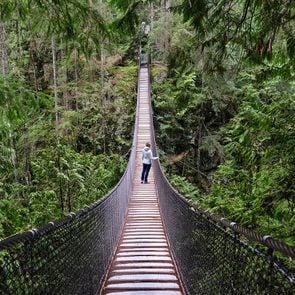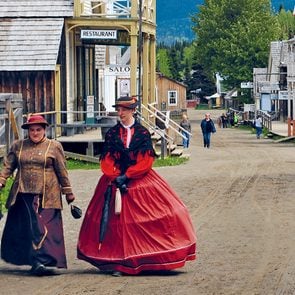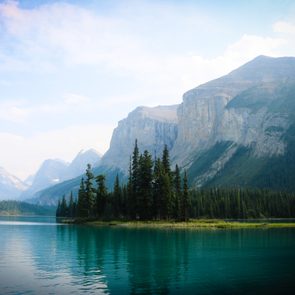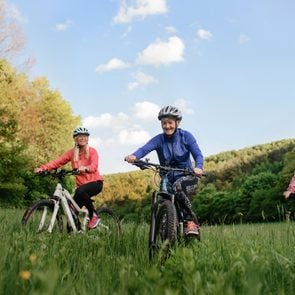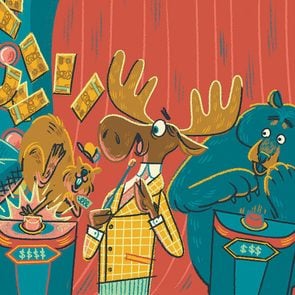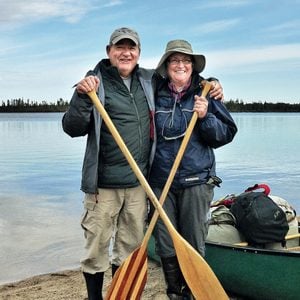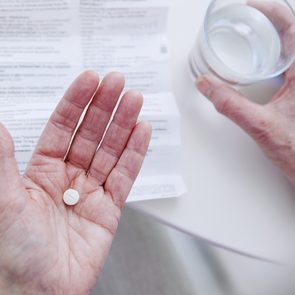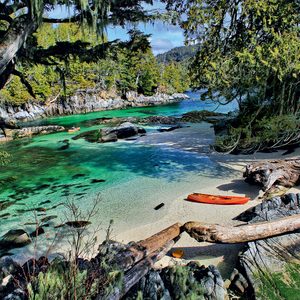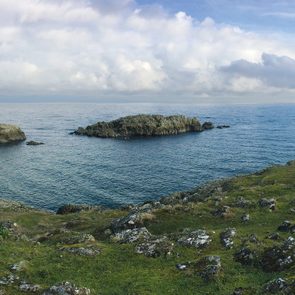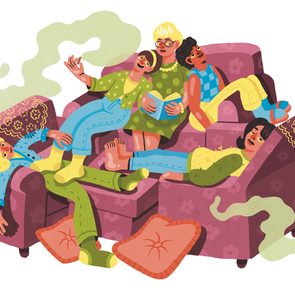
Confessions of a Card-Carrying Landlubber
I am not a fan of being on the water. I’m convinced that sea monsters or some other evil is lurking under the surface to take down the boat that I am on. So trust me—the irony of me writing about my incredible adventures on B.C. waters last summer does not escape me. My adventure actually began seven years ago when my husband, Mark, and his friend, Neil, purchased a boat to help share their love of the water with others. I suppose that “others” also included me, an idea I fought against for, well, about seven years, until last summer.
“Trust me,” my husband said. “You’ll see. You might actually like it.”
For those of you who love the water, you will laugh at my hesitation when I tell you that this boat is an 80-foot wooden tugboat. Yes. 80 feet! And a tug. You cannot get any sturdier than this baby. Built in 1941, this vessel began by working the rivers, then was sent off to assist in the war. It has now been renovated for comfort and adventure—for anyone who is looking for magic on the seas. And apparently for those who aren’t. I hopped on board the Union Jack at the Vancouver Maritime Museum and joined my family, some friends and the crew, including a chef! The goal was to explore the B.C. coast for three weeks. To say that I was apprehensive was an understatement—just ask the chef who hugged me and told me that everything would be okay as we pushed off the dock. Our captain, Captain Drew, took us to the most fascinating places in our three weeks! We discovered an island with its feral sheep (what a sight that was!), swam in its warm waters and picnicked on its white sandy beaches.

The Magic of the B.C. Coast
One morning, while enjoying my cup of coffee, Captain Drew called to me, “Head to the bow!” Oh, the magic! Pacific white dolphins were playing at our bow! Watching two, no three, no six dolphins playing at our bow was both magical and breathtaking. I was the only one at the bow to witness this beauty, this joy, this playfulness. My face hurt from smiling. My soul burst with joy. So much for sea monsters.

Serene Scenery
As we chug-a-lugged from one destination to another, I was amazed at the beauty of the B.C. coast. The greens, the blues, the sunsets, the sunrises, those stars—and most of all the silence, the stillness, the peace. I have never slept so well, ate so well, relaxed so much.
Oh, the food! I haven’t mentioned the food. It was so delicious! Salmon burgers for lunch—so good that I asked for one for breakfast the next day. The steaks were heavenly. And whatever she did to make her salad dressing—all I can say is she needs to talk to the hosts of Dragon’s Den and get that dressing on the grocery store shelves! Yummy!

Wondrous Wildlife Encounters
One of my favourite days was the day that Captain Drew looked to his left and looked to his right and asked me, “Hey, Deb, left to watch the orcas or right to watch the humpbacks?” The previous version of me would have replied, “Drew, whichever one gets me to land the fastest.” That day, I exclaimed, “RIGHT!” What magical creatures all whales are, but watching those humpbacks feed was awe inspiring. Drew kept a respectful distance from the whales, and with our binoculars, we witnessed pure beauty. Drew invited Jackie Hildering (known as the “Marine Detective”) on board to educate us about the humpback whales that she researches. Her enthusiasm and her passion made me want to be a marine biologist. May I remind you that I am not supposed to like the water?

Hidden Gems of the B.C. Coast
Then there was the day we went ashore at Teakerne Arm Provincial Park, walked past the top of a waterfall and swam in a freshwater lake. The water was refreshing and cool, and the snacks that were packed went down really well.

We also visited Yorke Island, which was established as a coastal fort to protect Vancouver during the Second World War. We met a passionate historian who, as he toured us around the old buildings, shared the stories of the men who protected our coast. Once again, we encountered people passionate about the work they do and the area they protect.

While in Alert Bay, we stood on the grounds of St. Michael’s, a former residential school, and visited the U’mista Cultural Centre, which was both educational and gut wrenching. Learning about the history of Canadian Indigenous people through this centre broke my heart, but also increased my admiration for their resiliency; I was humbled and filled with respect.

I’m in awe of the beauty and passion of the people who work and live on the B.C. coast. I also admire the courage of Mark and Neil, who embarked on a journey to share all of it aboard the Union Jack with Remote West Coast Adventures. Remember when Mark said, “Trust me. You might actually like it.”? Well, he was wrong. I loved it.
For more adventures on the B.C. coast, check out 25 reasons to visit Vancouver Island.
For Françoise Fontaine, acne was but a long-ago memory of adolescence. Yet there it was, unmistakable, little red bumps in a straight line across the Paris resident’s forehead that a friend noticed after a day of shopping.
It must be an allergic reaction to the clothes I just bought, she thought. But just in case, Fontaine called her long-time doctor the moment she got back home and described her symptoms.
“I think I know what you have,” the doctor told her. “There is no need to panic. My assistant will bring you anti-viral medication, which you should take right away and go see an eye specialist as soon as possible.”
The next morning, Fontaine was sitting in the specialist’s office, shocked as he informed her she had a virus called shingles, also called herpes zoster.
What causes shingles?
“It occurs when a virus called varicella zoster, which causes chicken pox, reactivates,” he explained. “You had chicken pox as a child, no?”
She had. But she didn’t know the virus that caused it had been lurking in the nerve endings of her spinal cord ever since, dormant, waiting to catch her immune system off guard before pouncing again. Or, that for some patients while the rashes and blisters fade, the tingling and burning from what is called post-herpetic neuralgia, or nerve damage, can last with little respite.
That was almost a decade ago. Now Fontaine, says: “I was lucky. The outbreak didn’t affect my eyes. But no matter what I try, the pain persists to this day. In that way, I guess I’m not so lucky.”
Coping with a shingles diagnosis
Most shingles outbreaks last no more than a week or two but some patients are at greater risk of developing life-threatening complications, including those who are undergoing treatment for cancer.
Research released back in 2015 found that a severe case of shingles can raise the risk for stroke and heart attack—and kill. Caroline Minassian, PhD, and colleagues from the London School of Hygiene and Tropical Medicine in England looked at the records of more than 67,000 U.S. Medicare patients who had shingles and suffered either a stroke or a heart attack within a year.
“We observed a 2.4-fold increase in the ischemic stroke rate and a 1.7-fold increase heart attack rate,” researchers reported in the Public Library of Science Journal. “The most marked increase was observed during the first week following zoster [shingles] diagnosis.”
Researchers suggested two possible reasons: the virus causes fatty build-ups in the arteries to break off and cause a stroke or a heart attack, or the stress caused by the pain sends blood pressure up, again resulting in a stroke or a heart attack.
Further research into shingles at the Mayo Clinic in Minnesota also showed that adults with asthma appeared to have a 70 per cent higher risk of developing shingles, compared with those without asthma.
There is no cure for shingles. Its name comes from the Latin and French words for “belt” because it often appears at waist level, partly circling the body. Dr. Allison McGeer, a microbiologist at Toronto’s Mount Sinai Hospital, enumerates the symptoms, which tend to occur on one side of the body because only a single nerve root is usually involved.
These may include numbness or tingling, itching and fatigue, headaches, high fever, a sensitivity to light and excruciating nerve pain that can upend your life, leaving you sleepless, unable to work or carry out daily activities.
“As you get older, your immune system stops paying attention to the virus for a period of time so that it grows down the nerve root, unimpeded.” Dr. McGeer explains. “The resulting skin rashes have distinctive shapes because they follow the pattern of the nerves as they give feeling to our skin.”

Is shingles contagious?
Unlike chicken pox, shingles is not contagious. If you are exposed to someone with shingles, you will not get the virus as long as you have had chicken pox, Dr. McGeer says. However, if you’ve never had chicken pox and are exposed to someone with shingles, you may come down with the childhood disease.
Timo Vesikari, a professor of virology at the University of Tampere in Finland, and director of the institution’s vaccine research centre, says most people will have only one shingles outbreak in their lifetime because it serves as a reminder for the immune system to become vigilant again. Still, depending on how old you are when the first outbreak occurs, it is possible to have a second one and maybe even a third. With life expectancies in Europe and North America longer than ever before, and with the baby boomer generation well into shingles territory, physicians are girding themselves to see more cases than ever before. Says Vesikari: “Think of it this way—if we all lived for 200 years, then everyone would develop shingles at some point.” Given that one in three adults over the age of 50 will develop the disease, it is best to prevent an outbreak in the first place. “For this you have to get a vaccine,” says Vesikari. If you’ve not been vaccinated, then you need to act quickly, at the first sign of symptoms, as the anti-viral medication is best used within 72 hours of an outbreak. This is especially important if you are hoping to mitigate the very painful post-infection pain that can often occur. (Try these pain management strategies for everyday aches and pains.)
Preventing shingles
Currently, there are two vaccines, according to Health Canada. The first, Zostavax, was approved for use about 15 years ago and reduced the chance of an outbreak by 64 per cent. But with ingredients such as live chicken pox virus, it was difficult to produce in large quantities and, thus, expensive. As for efficacy, experts believed it only offered immunity for about five years.
The newer vaccine is called Shingrix, and is the one Health Canada recommends for people aged 50. Unlike Zostavax, Shingrix does not contain any live virus, and instead combines an easily replicated protein found in the virus with an adjuvant, or chemical substance, that helps the body’s immune system wake up. Adjuvants are already used in vaccines to prevent a host of conditions, including hepatitis A and B, diphtheria and tetanus, but this is the first time one has been used in the battle against shingles. Shingrix is generally thought to be more effective and longer lasting.
As always, speak with your healthcare provider for the best fit for you as previous history needs to be taken into account.
If you have not been vaccinated, learn to recognize the early signs of shingles and call your doctor as soon as you suspect something’s wrong.
Vancouver resident Marilee Sigal wishes she had done just that when she had a shingles outbreak a few years ago. Having just turned 55 at the time, she was sitting with guests in her back garden when she felt a sharp pain high on the left side of her back. At first, she attributed it to fallout from a fierce childhood battle with scoliosis, a sideways curvature of the spine.
But the pain didn’t subside. It got worse. A day later Sigal noticed a mark like an insect bite. Another day after that, she went to a walk-in clinic. There the doctor examined it and said, “I can wait for test results, but I’ll tell you right now that it’s shingles.” Sigal was surprised. As a psychotherapist, she kept up on medical literature and thought she would be at risk only when she reached 60.
The doctor prescribed antiviral medication, but it was too late because Sigal had experienced the first symptoms more than three days earlier.
For Françoise Fontaine, the journey has been difficult. She has tried all kinds of therapies, from acupuncture to hypnosis to stop the burning pain. But nothing has worked. “I have to protect my skin from the sun and the wind because it hurts,” she says. “Some nights, it is just awful. I can’t sleep and I scratch myself until I bleed.” Still, she goes on one day at a time, spirited and determined to live each one to the fullest.
Next, check out 20 symptoms you should never ignore.
“Who knows what evil lurks in the hearts of men? Only the Shadow knows!” So said the character Lamont Cranston on radio’s The Shadow in the 1950s. We listened to that eerie invisible crime fighter’s voice, while audiences in Toronto and Montreal were also watching Howdy Doody and The Plouffe Family on television. Moreover, border cities were picking up American TV programs such as Texaco Star Theater Starring Milton Berle.
In other words, television and oldtime radio in Canada were at a crossroads: radio receding, television emerging. Like many others during that time, I was thoroughly immersed in both mediums, with each having a different effect on me.

Radio Days
In our home, a Sparton radio sat in the living room beneath the glow of our floor lamp. I huddled up to the radio as if listening to a campfire storyteller.
Evening radio, especially, measured my week. The Whistling Cowboy on Sunday began the entertainment on our local station. After the program ended, I was inspired to go galloping up our dusty street to play with a friend who, like me, loved to yodel.
Then through CBA Sackville (CBC Radio’s Maritimes outpost) came Our Miss Brooks, starring Eve Arden as a sarcastic English teacher in love with the shy biology teacher Mr. Boynton, played by Jeff Chandler. Later still came Jack Benny debating inane topics suggested by crooner Dennis Day, with Jack typically responding, “Now, cut that out!”
Monday-evening radio affected me even more. I’d turn the dial to CBA and crawl under a blanket on the sofa as Ken Carpenter’s silky voice intoned, “Lux presents Hollywood!” Classic movies such as Laura, a mystery/romance about a missing woman, followed.
Nothing compared to Lux Radio Theater’s thrilling Secret of the Incas. Although just as terrifying was Suspense—this time, a cryptic Harlow Wilcox said: “Autolite presents, Suspense!” In one episode, I listened to a countdown in a bunker: “5, 4, 3, 2, 1…,” but nothing happened. Then came the sound of a vehicle roaring across the desert to a tower containing a bomb. Technicians were heard clanking up the ladder to tinker with the wires. Suddenly, there was an explosion! Such an episode of radio realism fit the Atomic Age very well.
Another evening, I listened to I Was a Communist for the FBI, with Dana Andrews playing Matt Cvetic, who was an actual person who infiltrated communist cells thriving in the McCarthy era. Episodes always closed with a variation of the line, “I walk alone.”
The patriotic spy drama made me want to stand tall and salute the radio. This feeling was not farfetched, because Canada had our own Matt Cvetic: Igor Gouzenko, a Soviet Embassy decoder who’d defected. Radio was capitalizing on the Red Scare.
Topping my week was Gunsmoke, which we listened to over a static-filled WCBS New York channel. William Conrad voiced a commanding Matt Dillon, who rode the radio range until 1961.
The next year, Suspense and another detective series, Yours Truly, Johnny Dollar, ended their runs—this was often cited as the end of the golden age of radio.
But why did radio drama trigger my imagination so much? Appealing solely to my ears rather than my eyes, radio dramas created a theatre in my mind. As I would learn years later in Marshall McLuhan’s book Understanding Media: The Extensions of Man, radio was “hot”—old-time radio, in particular, intensified one’s sense of hearing. This explains why I could “see” that atomic bomb exploding unexpectedly in Suspense.

Time for TV
Meanwhile, television broke into my life. At first, I would glimpse Liberace’s fingers dancing over the keys on a TV in the window of an electronics store. Finally, in 1956, the manger of CFCY Radio launched Channel 13 Charlottetown. I was 15. My mother told me the exciting news while I was away at summer camp.
When I got home, I noticed my parents had moved the Sparton radio to a discreet area between our front windows. A four-legged television with rabbit ears now occupied the Sparton’s former hallowed spot.
Seated on the chesterfield, I was so eager for my first program that I even watched the preshow pattern. At last, a picture appeared, but all I saw was a jester cavorting before fake trees. That show, of course, was The Peppermint Prince, who delighted children. Viewing did get better: I was soon
laughing at Ernie Kovacs puffing his cigar like Groucho Marx.
Raised in the radio era, I was now entering the world of TV. My favourites slowly emerged. Sunday again became a key time, especially in the afternoon. First was You Are There, narrated by Walter Cronkite. The program lived up to its name. For example, thanks to the “reporters” (actors recreating the events), I felt like I was actually on the scene as German naval officers planned the scuttling of the limping battleship Graf Spee in Montevideo Harbour.
Then, in 1960 I discovered The Twilight Zone, which began with Rod Serling’s introduction: “There is a fifth dimension beyond that which is known to man.” This led into episodes such as “The Monsters Are Due on Maple Street,” in which aliens land in a town, creating such terror that neighbours turn on one another.
Unlike radio, TV heightened not just one sense, but used sight and sound, which further drew us into the program. As McLuhan wrote, TV was “cool,” requiring our participation.
Live TV really hooked me. By mid-1958, the Trans-Canada Microwave network (built to carry telephone and television signals from the nation’s
East Coast) had launched. I watched as TV cameras focused on Ripple Rock (an underwater mountain) within Seymour Narrows, B.C., near Campbell River. Engineers had tunnelled under the seabed and inside the rock to place explosives. In an instant, I witnessed Ripple Rock disappear in a plume of smoke and debris. And I felt as though I was actually present at this historic moment.
If you’re wondering whether the Lone Ranger will ever ride again or if Rod Serling will stir our fears with his words, take heart. Like a phoenix rising from the ashes, vintage radio and television continue to live on, viewable on our computers and iPads: after all, good entertainment is timeless.
Next, take a look back at classic TV shows that could only have been made in Canada.
Reader’s Digest Canada: We’ve always had inflation—but why? Is it a good or a bad thing?
Talan Iscan: Inflation is the rate at which the prices of goods and services increase over time, so people tend to think of it in negative terms—things getting more expensive is bad. But a modest amount of inflation is a sign of an economy in which demand is greater than supply, which raises the value of goods and services. This typically corresponds to low unemployment and, depending on several other factors, can also indicate prosperity. When prices drop, it’s usually due to low demand and is a sign of a recession or depression, which usually leads to high unemployment. The ideal inflation rate ranges between zero and five per cent. If we were to suppose that inflation was at two per cent, a pack of gum that costs one dollar this year would cost $1.02 next year.
Canadian inflation hit a 30-year high—5.7%—back in February 2022, and has been increasing since. Why is inflation so high in Canada? Is it because of the pandemic?
Yes and no. The drivers of the current inflation rate are a perfect storm of several factors, some of which began well before the pandemic. They include the 2008 financial crisis and trade wars between the U.S. and China, which resulted in tariffs on Chinese goods that have meant higher prices for North American consumers. Overall, the last few years have brought a skepticism toward the “global economy” model, with China increasingly looking to increase its own domestic demand rather than sell goods at low prices to the rest of the world. That move prompted supply-chain disruptions, then the pandemic came along, further hindering supply chains and resulting in a huge amount of pent-up consumer demand.
Can you give us an example of how inflation works with one commodity?
If we look at the price of beef, which is up by 14 per cent, you can look at droughts that happened in Western Canada and the U.S. last summer, putting a huge dent in supply. And then there were supply-chain issues attached to the pandemic, as well as labour shortages. So suddenly you have less beef, which means greater demand, which means suppliers will charge more and retailers will pass that increase on to consumers. That is a fairly local example, but then you take something like the spike in gas prices; that involves a whole bunch of global factors including, now, the U.S. ban of Russian oil.
Would a more conservative approach to government spending during the pandemic have saved us from the currently high level of inflation?
Fiscal spending has definitely been a factor, but that money was largely spent on the most vulnerable groups—and where would we be now if these people had not received the help they needed? Certainly there would be less demand, but we would have higher unemployment numbers because many businesses would not have survived. Would that be a better Canada? I don’t think so. But yes, you can point to our government’s spending if you’re talking about homegrown industries and goods.
So what’s next? Will this get better?
The hope is that, as pandemic restrictions are lifted and our supply-chain issues are resolved, we’ll be able to keep a robust demand while stimulating supply. The other thing is that inflation itself could have a cooling effect: more than half of Canadians are feeling the rising costs of goods and services in their wallets, so that’s going to have an impact on their purchasing power. And recently we are seeing the Bank of Canada attempt to tackle the demand side of the equation by hiking interest rates. That will have an immediate effect on anyone with a mortgage, car payments, debt and ultimately on the economy as a whole. But there is concern around anything that would restrict demand while we’re still coming out of the pandemic, so it’s really about finding the right balance.
Next, discover the best shopping apps to save money on groceries.
Last summer, after a full year of COVID-19 restrictions, my husband, Kevin, and I were eager to accept an invitation to a wilderness canoe-camping trip. Due to travel limitations, camping sites were difficult to book, as their popularity seemed to soar throughout the province. Conscious of the need to physical distance and, with the rules constantly changing, a paddle-in camping trip seemed ideal.

Our Crotch Lake Adventure
We chose a mid-July three-night trip to Crotch Lake—situated in Ontario’s North Frontenac Park Lands within the Frontenac Arch Biosphere Reserve, and with a shore of almost all undeveloped Crown land. Our group of 15—most of us friends from the Cornwall Outdoor Club de Plein Air—was split into four sites, with three to four tents per site. Although our site was close enough to be visible to one other, the other two were across the lake, at least a kilometre’s paddle away.

Planning is Key
Most participants were experienced wilderness campers, but this was my first real paddle-in camping trip. The most difficult part for me was the planning and packing, trying to cram everything we needed into a canoe, being mindful of item weight and size, food preservation and weather. Meal planning was particularly gruelling. I couldn’t imagine how others, in their less spacious kayaks, managed.
We launched near Ompah, a village at the north end of the lake. Paddling on the open water along the rugged granite shoreline was incredible! We admired other campsites perched on rocky outcrops topped with conifers. As we drifted by, some campers on shore waved, as if welcoming us into the community.

Making Camp
Nearly two hours passed by the time we reached our site, which Kevin and I shared with two female friends. Our accommodations consisted of a firepit, an exposed bedrock patio overlooking the lake and, a little beyond our tents, a thunderbox. The latter was basically a loo with no walls, just a box with a seat in a forest clearing.
The surrounding forest was mostly thick and impenetrable. As a result, there was no opportunity for any significant walks, which we all found a bit confining. On the flip side, this forced us to take more time to relax and enjoy our surroundings.
If we got the urge to explore, we would do so on the lake, during our group daily paddles. With no cellphone coverage, we had to pre-arrange meeting points at areas on the lake that were central to the four sites.

Embracing Life in the Wild
We chose a different destination each day. First, we paddled to the Whitefish Rapids, where the Mississippi River rushes into the lake, to enjoy a shared picnic lunch. On the second day, we took a 13-kilometre round trip to the lake’s dam, where we got out to stretch our legs. And on our final morning, we snaked through the Crotch Lake Conservation Reserve, an area narrowed by two jutting peninsulas and dotted with small islands. Being on the lake gave us the opportunity to socialize as a group while enjoying nature’s offerings.
When not on the water, we remained with our camp mates—cooking, swimming, reading and performing basic tasks such as tending to water filtration and stringing up our food containers in the trees, away from opportunistic wildlife. Our site group was well-matched, all of us early risers. We enjoyed quiet evenings by the campfire and spent much time sitting on our stone patio by the water, gazing up at the stars, appreciating the sunrise and enjoying the peacefulness of being off the grid. Our entertainment consisted of watching loons do territorial circle dances, being startled by jumping fish and being amazed by the speed at which a beaver could swim past our site. Out in the wilderness, on hiatus from the worldwide madness, we could decompress and simply be.
The Healing Power of Nature
The trip reaffirmed the positive aspects of immersing yourself in nature. The simplicity of human interaction in this setting allowed us to engage in animated discussions and share laughter, dissolving our worries for a time—followed by the realization of how fortunate we are to live in such a splendid country. There’s so much beauty here! Were it not for the travel restrictions, I may never have explored this secluded section of the biosphere reserve.
Crotch Lake was an adventure I would enjoy repeating, pandemic or not. When everyday life gets overwhelming, memories such as this one engulf me and the desire to escape is strong. I can’t wait to trade my desk for a canoe and take off on another wilderness adventure with friends.
Story idea from: “The Circle Dance,” The Cornwall Seeker—Oct. 2021, by the author.
Wondering how Crotch Lake got its name? Find out in our roundup of the funniest place names across Canada.
We all know we’re supposed to drink lots of water. But that can be hard to do when water tastes so… Watery. Luckily, it’s possible to get hydration from a variety of drinks, but we have to be careful that we’re not having too much of the ones that dehydrate.
That’s right: Some liquids actually encourage more water to leave your body. Plus a lot of tasty drinks include too much of things you’re looking to limit or cut out altogether, like sugar, carbs and a bunch of calories. Our list will help you determine which are the best hydration drinks—and which beverages to avoid. (Find out more surprising health benefits of staying hydrated.)

The Best Hydration Drinks
Curious to see which beverages are the best for keeping enough fluid in you? The first three are hands-down your best hydration drink choices; the rest are nice supplements.
Water
Surprised? Plain water is the best way to hydrate, no second guessing necessary. (Here’s what happens when you start drinking eight glasses of water a day.)
Milk
Because it’s so much thicker than water, you might think that milk could dehydrate, but studies have repeatedly shown that’s not the case. In addition to calcium and vitamin D, milk contains protein to keep you fueled on even the hottest of days, another thing water can’t do. Milk: It’s not just for kids.
Fruit-infused water
If it’s hard for you to drink plain water all day, infusing your water with fruit is a healthy way to add flavour without adding excess sugar. Our favourite combinations? Try adding lime and basil, or cucumber with mint.
Fruit juice
Fruit juice contains about 85 per cent water, which makes it super hydrating (just make sure you’re picking 100 per cent fruit juice). The vitamins within natural fruits are also healthy. Be mindful of the sugar content, though, as juices can be packed with added sugars, which can inhibit hydration. If you’re drinking a lot of fruit juice, water it down.
Watermelon
OK, so this isn’t a drink… But every time you eat watermelon, you’re retaining 92 per cent of the liquid you’re eating. That’s better than fruit juice!
Sports drinks
Advertisements rave about the hydrating power of sports drinks, like Gatorade, which made us suspicious… But they’re actually onto something. The electrolytes, a science-y word for salts, in sports drinks can make hydration more effective. (Not to be too gross, but you know how sweat’s kinda salty? You want to add that back into your body.) Sports drinks also taste more flavourful than water, so they’re easier to drink quickly for those who force themselves to hydrate or who need quick hydration, like athletes. Again, watch the sugar and carb content, especially if you’re not working out. Unless you’re running a marathon, one rehydration drink is probably enough.
Tea
Caffeine-free teas are great, especially if it’s just an infusion of leaves in hot water. It doesn’t matter whether it’s herbal, black, green or chamomile; hot or cold—tea is just about as hydrating as water. Tea is also packed with antioxidants. While the best option might be to avoid caffeine in general (it’s a diuretic, meaning it dehydrates), drinking even regular tea in moderation will help you reach your daily goal. Check out more incredible health benefits of green tea.
Coconut water
Coconut water boasts 95 per cent water content, which is better than fruit juice. It’s also typically healthier than juices and sports drinks when it comes to sugar content and added ingredients, but be sure to check the label. (Here’s how to read nutrition labels like a pro.)

The Worst Hydration Drinks
Sneaky fact: Some liquids can actually work against your hydration goals. Make sure you’re not reaching for any of these beverages next time you’re thirsty—they only dehydrate your body!
Soda
Soft drinks often contain caffeine, which is a culprit for dehydration; tons of sugar and sodium; and it’s bad for your bones and teeth, too. Although just about anything in moderation is fine, grabbing a diet cola when you’re thirsty might not do much to help. Swap out soda for sparkling water if you love that carbonation while still giving your body the fluids it needs. (Find out exactly how sugar is making you sick.)
Beer
Consuming any kind of liquor removes water from your tissues, meaning you have to drink even more water to offset the effects. As a general rule of thumb, the higher the alcohol content, the more dehydrating your drink is. If you want to avoid dehydration, have a low-alcohol light beer.
Wine and hard liquor
Any alcoholic drink over 10 per cent alcohol strength is a dehydrator, which means more of the liquid will leave your system than be absorbed. Most wines have around 12 per cent, so they’re better than hard liquors (37 per cent) but worse than beer (4-5 per cent). Once again, we advise moderation. (Here’s what happens when you drink a glass of wine every night.)
Cocktails with hard liquors, like vodka and rum, can be deceiving, especially if the recipes also include soda or fruit juice. Keep yourself hydrated by always drinking one glass of water for every alcoholic beverage you have—and consider switching to something less potent (like beer or wine).
Hot cocoa
The bad news? One cup of hot chocolate contains more sugar and calories than a can of soda, dehydrating your system. The good news? You’re probably not drinking this in the summer, when it’s most important to consciously hydrate. In the winter, people tend to eat more soups and stews, which offer hydration, so having the occasional hot cocoa isn’t going to hurt.
Coffee
In moderation, coffee isn’t too bad, but once you go past that second cup, your body really starts to suffer. Drinking more than 200-300 milligrams of caffeine—the amount in two to three cups of coffee—has been shown to lead to dehydration. To keep yourself safe, switch to decaf or limit yourself to a cup or two. Bonus: Less coffee can make you less anxious. Learn to spot the signs you’re drinking too much coffee.
Lemonade
Although the sweet-and-sour flavour can be tempting in the heat, lemonade is packed with sugars that don’t offer much toward your body’s needs. Swap this out for water infused with lemon slices and you’ll feel much healthier.
Sweetened iced tea
This staple screams summer, but when it comes to hydration, it’s not so sweet. The amount of added sugar in this drink cancels out any benefits that come with tea’s antioxidants, so it’s more like a dessert than a drink. That doesn’t mean you can’t drink it… It just means you have to drink plenty of water with it, too.
Energy drinks
Packed with caffeine, fake sugars and complicated chemicals, energy drinks are not hydrating. If you’re looking to energize while still getting in more liquids, we suggest tea.
Flavoured milk
White milk on its own is totally fine, but you start to add unnecessary sugars when you throw flavours in there. Avoid chocolate, strawberry and vanilla milks and stick to good old-fashioned plain until you’re fully hydrated.
Smoothies
Fruit is healthy to eat on its own, but sometimes you can have too much of a good thing. Smoothies pack more fruit (read: more naturally-occurring sugar) into your drinks than you’d think. Add that to the thick consistency and you may have a recipe for dehydration. That’s not to discount the other health benefits of smoothies, though. They’re great to refuel after exercise or kick-starting your day with a dose of vitamins. If you want to up the hydration factor, an easy solution is to double the amount of ice in your recipe. This will water down the drink without changing the taste too much.
Now that you know the worst hydration drinks, find out exactly how much water you should be drinking.

The Secret of My Grandfather’s Success
Many people in the workforce have a goal or a dream, but they do not know how to fulfill it, which can lead to them feeling hopeless. Everyone wants to reach their definition of success—but is one’s sense of achievement in the workplace really the key to happiness? I found a whole new perspective in the form of my grandfather’s “success” story.
My grandfather Alfredo Valentino has been through a lot in his life. He was born in a small town in Abruzzo, Italy, to a middle-class family who did work on the farm and had a little shop.
He would wake up at four in the morning every day to work on the farm. Although he was a great student in school, he only went up to Grade 3 because he was required to help with the family farm. He barely had any time to play or go out with friends, like any typical young boy would love to do. Instead he always had to work hard in order to contribute to the family business.

A New Start in Canada
In 1951, when he was 24, he heard they were looking for people to move to Canada. So he went to apply at the town hall (without his father’s approval) and got accepted. He could not stand his total lack of freedom any longer.
“If it weren’t for my father always making me work, I would not have come to Canada,” my grandfather says.
His parents did not give him any money for this journey. So he used his own hard-earned savings—the small amount was all he had—to travel to Canada. In total, it took 11 days on a ship to reach Halifax and then 36 hours on a train to arrive at the Brampton, Ontario, farm destination. Back in the 1950s, almost everything was farmland and every young man on the ship was assigned to a different city to work; everyone was spread apart from one another. There was no way to communicate to the others he knew from the ship, except by sending letters. So, my grandfather was alone in a new country, far away from home, not knowing anyone and not speaking English or French. Despite these obstacles, his ultimate goal was to start a new life in order to escape the never-ending working life he faced in Italy.
At the farm in Brampton, the owner quickly saw what a hard-working young lad my grandfather was. So, instead of paying him the expected wage of 45 cents an hour, he paid him 75 cents an hour. Although the couple who owned the farm were very nice to him and treated him like family, he was not satisfied. He dreamt of being more successful, of better career advancements.
One day, he got an offer to work in the construction industry. That was a huge opportunity for a newly immigrated young farmer eager to move up in the world. Determined to start on his new vocation, he tried to sneak out of the house that night. But the stairs in the house made so much noise that the owners caught him red-handed before he could leave. He was afraid that they would be angry with him and send him back to Italy. Instead, they were understanding and asked him to at least finish his one-year contract with them before seeking other employment.
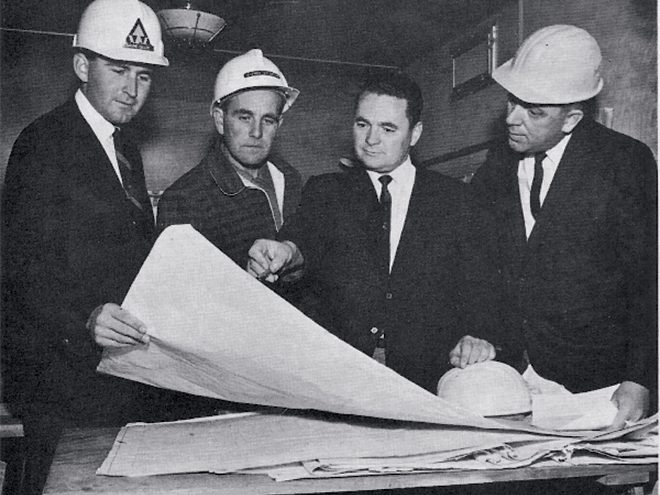
Building a Future
A few months after arriving in Canada, my grandfather did some work for Ignat Kaneff; they became friends and started a construction business together. One of their early success stories was the construction of Mississauga’s first high-rise building, which consisted of 262 apartments. They completed many other projects together and were constantly busy.
My grandfather prospered through hard work and the way he used his natural skills to his advantage. That’s how he became successful in Canada. Around 1967, however, he become overwhelmed with stress, sleepless nights and anxiety from the business. He also had two young daughters (my mother and my aunt) to take care of, as my grandmother was in the hospital at the time. The combined stress and anxiety unfortunately drove him into a major depression. During a medical checkup, his doctor asked him, “What do you want, your money or your health?”
“Both!” my grandfather replied. But he knew what was best for him and asked to be bought out of the business. He then began a smaller business of his own, which resulted in less stress and more time with family. Had he chosen not to quit his former job, he might have been a billionaire today. But family and health are more important than wealth.
Sometimes you do not get what you want in life—be it top employee status, highest pay or prestigious awards—but in the end, what you get is better than what you desired. Of course, it is still important to work hard, and people should strive to reach their goals. But what is the most important is to not allow work to take over your life—or take your life away.
My grandfather will turn 95 in October; even at this ripe old age, he is still strong, well and high-spirited. Looking at his story as a life example, he teaches us to work hard, but at the same time not to forget to have fun, enjoy life and have a good sense of humour about it all. Work is important, sure, but there is much more to life than just that. Overall, this is the ultimate key to happiness.
Next, find out what one recent immigrant wishes he’d known before moving to Canada.
Michael Wharrad held the envelope in his hands, certain of what the paper inside would tell him. A decade ago, the 72-year-old, a former investment banker who lived in Kent, England, had been diagnosed with Parkinson’s disease. For a year, he had participated in a drug trial at London’s National Hospital for Neurology and Neurosurgery. Researchers were testing whether a medication approved to treat type 2 diabetes could also treat Parkinson’s symptoms. Every day, Wharrad had received a dose of either the drug or a placebo, but he never knew which.
During the trial, Wharrad thrived. His joints ached less, and he could get up from a chair more easily and take walks around the block. He also noticed that his memory seemed stronger. Friends and family commented on his obvious improvement. “My wife and I were convinced I was taking the drug,” he says.
But at his end-of-trial meeting with one of the researchers—who also didn’t know whether Wharrad had been on the drug or not—he was delivered a surprise. When he opened the envelope to find out what he’d been taking, he saw the word “placebo.”
“I was speechless,” he says. “I had been feeling so much better.”
How Placebos Work
A placebo can be a sugar pill, a saline injection or a glass of coloured water: inert treatments that shouldn’t produce a physiological response. But they often do; Wharrad’s case is not unusual. In fact, placebos are increasingly proving to be more powerful than active drugs in trials—and they may just be the key to reducing our dependence on medications.
The so-called placebo effect happens when the brain convinces the body that a fake treatment is authentic, which stimulates relief. The medical community has long been aware of this phenomenon, but in the last 50 years, neurologists began examining the molecular mechanisms and pathways at play when a mock treatment creates real healing. To a large extent, it’s still a mystery, but scientists have confirmed that simply perceiving that you’re being treated affects the part of our brain that processes symptoms.
Since the body-brain response that controls the placebo effect is neurological, they work best for conditions controlled by the neurological system, such as pain, irritable bowel syndrome, depression and Parkinson’s disease. Placebos can’t change things like a viral infection; they won’t lower your cholesterol, shrink a tumour or reduce a cold’s duration.
When they do work, expectations play a significant role: if you think a pill can cure you, it is more likely to do so. In a Lancet review of placebo studies, researchers described a case where post-surgery patients were given morphine for pain. For some, the medication was delivered secretly with a hidden pump, while others received it from a physician who explained that it would make them feel better. The patients expecting the drug and its positive effects experienced far greater pain reduction than those who were unaware they had received it.
Just As Good As Active Drugs?
Placebos can also work as a result of “pharmacological conditioning”— when clinicians teach a patient how to respond to a placebo by first administering an active treatment. According to Luana Colloca, a professor at the University of Maryland’s department of anesthesiology, this can result in the strongest placebo effect. Studying this phenomenon across a range of conditions, Colloca has observed via fMRI scans and other objective measurements that placebos use the same neurological pathway of the brain as the medication did. “The placebo response is like a pharmacological memory,” she says, explaining that it’s similar to a trauma response, where the brain reacts in a certain way to a traumatic event and then is later triggered to replicate that same response.
This specificity means that placebos for depression activate serotonin, and those replacing painkillers reduce activity in the brain centres responsible for pain while activating the opioid systems, or pleasure centres. In other words, your brain is tricked into generating a drug response.
Placebos are so powerful that they’re affecting the chances that a medication will be approved for use. To prove a drug works, scientists must show that it performs significantly better than a placebo in a randomized, double-blind, placebo-controlled trial (in this type of trial, neither the researchers nor the participants know who is receiving what). Over the past two decades, scientists and drug companies have noticed that placebos are helping patients so much that some drugs can no longer outperform them—not because the drugs are less effective but because the mind’s power over the body seems to be growing. In fact, a 2021 Danish meta-analysis of 180 drug trials showed that, in total, over half of the treatment effect could be attributed to a placebo.
This increase is not well understood, according to Lene Vase, a professor of neuroscience and psychology at Denmark’s Aarhus University, but it’s presenting a problem for drug companies.
“Some drugs that were approved in the past would not beat a placebo today,” she says.
Currently, this phenomenon seems to be strongest in the United States. Testing results for the drug lumateperone provide a typical example. In 2019, pharmaceutical company Intra-Cellular was on the verge of a major development for the treatment of bipolar depression; it had performed well in earlier trial phases, and the company’s scientists were expecting success. Yet in the American arm of the trial, patients who received the drug and those who received the placebo both experienced significant improvement. When Intra-Cellular released its findings showing the drug had failed to consistently outperform a placebo in part of its trial, its stock dropped 22 per cent—although it was later approved by the FDA due to successes in other countries.
Dr. Jeffrey Mogil, who studies pain at McGill University, published a paper in 2015 showing that the placebo effect has increased, especially in the United States. He posits that, because American trials are often more expensive and hosted in nice clinics, the patient is conditioned to believe the medication must work. Neuroscientist Alexander Tuttle, a co-author of the McGill study, hypothesizes that advertising also plays a part: Americans who view ads depicting patients helped by pharmaceuticals could also be more likely to believe the pill they take in a trial will heal them.
(The U.S. is the only country besides New Zealand that allows pharmaceutical companies to advertise prescription medication directly to consumers.)
A Case For Transparency
Placebo research is now its own area of study, and experts say we should harness the strategies that generate the most powerful placebo effects in drug trials and incorporate them into clinical treatments. It may sound unlikely, but in some cases, placebos work even if you know you’re taking one.
The effectiveness of “open-label placebos”—sometimes also called “pure” placebos—has been shown in numerous studies. In one published in the journal PLoS One, a team of researchers gave patients with irritable bowel syndrome inactive pills labelled “placebo.” Those patients experienced a 60 per cent improvement in their condition, while those receiving no treatment only improved 35 per cent. “The key ingredient to successful treatment with a placebo is honesty, not tricks,” asserts Dr. Ted Kaptchuk, the director of Harvard University’s Program in Placebo Studies and Therapeutic Encounter, who led the study.
Already, without telling patients, some doctors prescribe an active treatment—a vitamin or antibiotic, for example—that they know will likely not treat their ailment but may generate a placebo effect. In fact, a 2018 international review of studies from 13 countries found that up to 89 per cent of physicians reported using placebo treatments at least once a month. Doctors surveyed said they do this to treat non-specific complaints or to satisfy patients’ demand that something be prescribed. The hope, then, is that open-label placebos could replace this ethically murky practice. “Use of open-label placebos would reduce the amount of medication we use for common conditions,” adds Kaptchuk.
Although knowingly taking a faux treatment won’t be for everyone— Wharrad, for instance, isn’t convinced he would have experienced the improvements in his Parkinson’s symptoms had he been aware he was taking a placebo—one 2016 American study published in BMJ Open found that up to 85 per cent of the 853 respondents felt it was acceptable for doctors to treat with open-label placebos in various scenarios.
The Future of Placebo Research
In 2017, more than two dozen international placebo researchers gathered in the Netherlands to begin developing official recommendations around the use of open-label placebos, some of which were published last year. They include informing patients about placebo effects and fostering warm, trusting and empathetic patient-doctor relationships.
This potential transformation in medicine has already changed the lives of some patients who’ve participated in open-label placebo studies. Troy Mack, a 57-year-old Baltimore resident, had been suffering for two decades from intense pain in his face, neck and jaw from temporomandibular (TMD) joint disorder. When researchers at the University of Maryland, including Colloca, announced a study of an experimental TMD treatment, Mack was told that, based on his medical history, he could be a good placebo responder.
That prediction turned out to be correct. After just a week of knowingly taking a placebo, most of Mack’s jaw pain had disappeared. His face felt more relaxed, and the joint no longer cracked when he yawned. He was finally experiencing relief. “If I could get a long-term prescription for this, I would take it,” he says.
Now that you know why placebos work, find out if your supplements are doing more harm than good.
One weekend in 1995 while we were practicing tai chi, my roommate asked me if I was interested in going diving with him. With my own gear and a love for the water, I was always looking for someone who wanted to head to the ocean.
Back then, not too many people had their own diving gear, so it was hard to find someone interested in diving. I never acquired a large amount of money, so my gear was a used wetsuit missing a section of material the size of a small breakfast bowl in the crotch. Wetsuits aren’t made to keep you dry, but the neoprene material wrapped tightly against your body is designed to keep you somewhat warm for the first 40 minutes of diving. Unfortunately, if you have a decent-sized hole, that will affect how warm you stay. Every time I went diving, I came back out after 30 minutes barely unable to move from the cold, but it was worth it.
My Campbell River Diving Adventure
The conditions were perfect the day we chose to go Campbell River diving. It was calm and sunny, and visibility in the water was about 40 or 50 feet—which in summer is quite good, with algae and plankton everywhere. I was feeling in great shape. We went into a little bay just off Campbell River, the local popular diving spot, as there was always an abundance of wildlife to see. We laid out our gear, checked it over and made a game plan of our dive for the next hour. We planned on checking out the wildlife within the first 50 feet for the first part of the dive, then dropping down past 150 feet. This was something I was kind of excited about trying. I had never really been past 80 feet, as there was really no need. When diving, almost everything interesting to see is within the top 30 feet.
The dive spot for the first half-hour proved its popularity: The rock reefs were covered with starfish, sea urchins and crabs working their way around the crevices, looking for food as the odd shrimp wiggled by. Every once in a while, a jellyfish bobbed up and down with little stragglers feeling its way. Close to the rocks, the anemone closed their outer soft shells when touched, covering their colourful tentacles. As we moved through the long keep, a couple of wolf eels curiously circled us before disappearing back into the darkness. As we were hoping, a Pacific octopus did let us admire him before his long arms pushed him back int a small crevice within the rock. We did not see any seals that day; however, we were able to watch hundreds of different kinds of fish.
Into the Depths
My roommate motioned to me, by thumbs up, to see if I was okay, then pointed down a rock formation with no bottom in sight. After replying back I was okay, we started down the rock wall. As I looked at my depth gauge, it slowly read 60 feet, 70 feet…then 100 feet as we continued down the rock. I was excited and nervous as I looked around, because I didn’t know what was ahead of us; this was something I had never experienced.
It was the weirdest feeling to look upward and find that the sky and ocean surface were no longer there. There was no wildlife in sight, other than barnacles glued to the rocks—and the two of us slowly descending. I started feeling as if life completely stopped and there was only the darkness all around us. You think it’s dark at night, but there is always some form of light around to give direction; at 120 feet deep with nothing but a flashlight, it was enough to make the hair on the back of my neck stand up.
We hit about 140 feet when we stopped descending. My roommate then wrote a simple addition question on a small underwater board, wanting me to answer it. He was a divemaster and was making sure that my brain was still functioning properly. With a tank, you can only dive to about 130 feet safely. After that, physiological changes brought on by pressure become greater and greater the deeper you dive, and compressed air breathing can lead to nitrogen narcosis and other problems. Being a smart ass, I decided not to do the addition problem but instead did it as a multiplication problem. He smirked at my answer and knew I was still fine, so we descended a little farther.
Terror at 160 Feet
The thing was, even though I was okay, I was very nervous about being so deep with no sight of anything. It was complete darkness—not even a shadow. I am not claustrophobic, but I was definitely feeling a bit of it. If something happened, I would be in trouble. The air in my tanks said 1,500 psi, and this is the time to ascend. The deeper you go, the greater the quantity of air is required to fill your lungs. I knew I had to try and slow down my breathing and start upwards in five minutes, which I was looking forward to.
I still don’t know why I didn’t stop and give the sign to go up, but I guess I proceeded down for the thrill of the unknown. I didn’t know till afterward how deep we went, but when we hit 160 feet, I started to lose it. I didn’t know where I was or what I was doing. I just recall looking upward, scared out of my mind. I didn’t know anything about my life, or what I did for a living. I didn’t need to communicate—I guess my eyes and facial expression said everything. My roommate was holding onto me and slowly started upward, trying to calm me down.
Once we got back up to 130 feet, I remembered what we were doing—or at least I knew who I was—but in the darkness, I still wanted to get out of the water NOW. We couldn’t just go straight up, though. Unfortunately, at that depth, we had to stop for five minutes a few times on the way up for decompression. The closer we got to the surface, the more I started to feel relaxed, especially once I saw some light above us.
We eventually did get up and out of the water, and then my buddy let me know that I had experienced nitrogen narcosis; in diving vernacular it’s called getting “narked.” Everybody varies in the depth they can reach before this occurs. Some divers have reacted by taking their air regulator out of their mouth and trying to give air to a fish, while others lose direction and try heading back by swimming deeper.
As a divemaster, my roommate’s depth was around 180 feet; he was seeing how I would cope when I got narked. It is something I never want to experience again; however, I am glad I did, for I recall clearly what I couldn’t remember—and the feeling of fear that went with it. I knew that in my future diving days, 130 feet deep would be my limit; from experience, there really is nothing more to see after 70 feet deep anyway.
Will you be adding Campbell River diving to your bucket list? Here are more hidden gems across B.C. worth exploring.

Imagine, if you will, a freckled, buck-toothed demoiselle of the groovy 1970s. I yearned for something more than my sister’s hand-me-down jeans and T-shirts. Enter the maxi dress. At first, only a few girls at school trailed their dresses through the playground dirt, but as the trend intensified and more and more friends flounced into school with ultra-long hemlines, jealousy became my newest accessory. Alas, my parents’ budget did not stretch to such frivolity. So imagine my delight when a family friend gave me a thank-you gift for entertaining her toddler after the arrival of twin baby girls. I opened the package, and there, nestled in tissue paper, was a paisley patchwork maxi dress. Le swoon.
Was it a pattern I would have chosen for myself?
It was not.
Was it odd that it came with a little elasticated granny cap?
Perhaps.
Should I have heeded those warning bells when I realized the fabric was flannelette?
Absolutely.
But desire and desperation are an intoxicating ensemble.
The next morning, I donned my new dress and went down for breakfast. My mother, perhaps tired after her night shift, made no comment. When I arrived at school, however, it was a different story.
“Are you wearing pyjamas?”
“No.”
“Is that a nightgown?”
“No.”
I knew the unasked question on everyone’s lips:
“Are you nuts?”
Clearly.
I draped myself in denial. I would get through this nightmare (for which I was all too suitably attired). I managed to brazen my way through the morning, but when the bell rang for recess, Mrs. M., my Grade 5 teacher, beckoned me to her desk. She was not particularly fond of me; I was too chatty for her liking. I suspected she’d summoned me to ask the same questions I’d heard all morning:
“Are you wearing pyjamas?”
And,
“Is that a nightgown?”
But she did not. Instead, she looked at me intently, pushing her glasses up her nose, then leaned in closer. Slowly, she reached out a hand. Had I misjudged her? Perhaps she had taken pity on me. Perhaps she would comfort me, offering reassurance that I would survive my fashion faux pas.
Her hand drew ever closer. I waited for the reassuring pat on my cheek. Instead, her fingers grasped my sleeve. She rubbed the material between her thumb and forefinger to identify the fabric. Then, with a satisfied look on her face, she dismissed me.
Meanwhile, in her head she asked, “Are you nuts?”
And in my head I answered, “Clearly.”
Years later, I met up with some old elementary school classmates. One of them remarked, “Remember the time someone wore pyjamas to school? Who was that?”
I decided to fess up. I mean, consider how much fashion has changed since the 1970s: Pyjama Day at school is now an actual thing. And with the current emphasis on working from home, our attitude on what to wear where has broadened. Let’s face it, one person’s loungewear is another’s PJs.
Clearly, 11-year-old me was just ahead of her time. And by that I obviously mean bedtime.
If you liked this funny fashion faux pas, check out this woman’s hilarious colonoscopy story.
